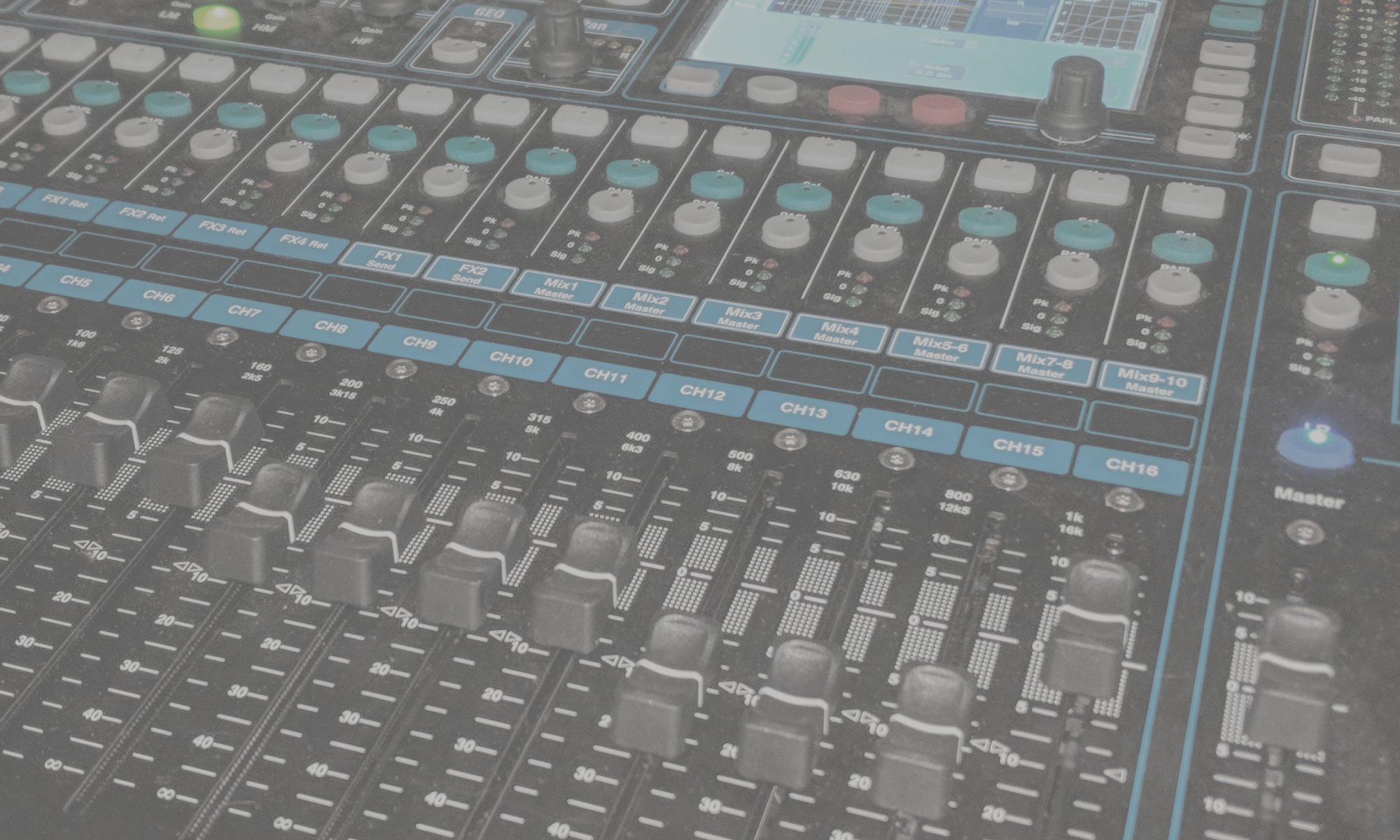One of the most common experiences in churches and other medium-sized venues is mixing monitors from the front of house position. In smaller venues, musicians won’t have monitors at all; they can hear themselves fine either acoustically or through the front of house sound system. In larger venues, there’s often another technician whose sole job is to mix monitors for the musicians. But in what seems like most venues, there’s only one person — and that person is likely you.
What’s the Scenario?
There’s really no way for this to cover every possible combination of musicians, venues, and equipment, so let’s imagine this scenario.
We’re mixing on a 16-channel analog board, and we have 2 aux sends available for our 3 monitor speakers. The main speakers are on stands to the left and right of stage, with no subwoofers. We have a smallish group with a drummer, bassist, keyboardist, guitarist (who also sings), and another vocalist. The channel list looks like this:
- Kick
- Snare
- Keyboard Left
- Keyboard Right
- Bass
- Guitar
- Vocal 1
- Vocal 2
With this situation in mind, let’s get started.
Communication is Key
The single most important thing when mixing monitors is communication. This is even more important when mixing monitors from front of house. Because we won’t be in a position to hear the monitors for yourself, it is up to the musicians to relay to us what they need to hear. Listening to the musicians response to their monitors is absolutely essential.
Listening, however, requires interpretation. If a vocalist says they cannot hear themselves in the monitor, that doesn’t necessarily mean their microphone should be turned up in their mix. We have to be at least somewhat aware of the state of their mix to know if what they really need is for the keyboard to be turned down.
This is easier with musicians who are more used to using monitors. With experience, a musician will get better at telling us what they want in their monitors and, as importantly, what they don’t want. Less experienced musicians will often think monitors need to have more content in them than truly necessary, which leads to a very cluttered mix. Worse, these cluttered mixes usually means more volume, which means feedback is much more likely.
Therefore, it’s important for us to communicate back to the musicians as well. Ask questions to seek clarity. Find out if instead of more of one thing, less of something else would be more helpful. Keep that two-way communication going.
Who Gets What?
Knowing that communication is important, how do we get from talking about monitors to actually putting sound in them? The first thing we need to do is figure out the setup. In our scenario; with 2 sends, 3 speakers, and 5 musicians; it means getting a little bit creative. The more resources a system has, the less creative we need to be, but in my experience, a system rarely has exactly what we wish we had.
What we need to do then is first decide where the speakers should actually go. In our case, I’d go with one speaker for the drummer, one shared by the bassist and keyboardist, and one shared by the vocalists. This mostly depends on where the musicians are standing. Drummers generally need their own speaker, mostly because there is usually a drumkit between them and the other musicians. Similarly, vocalists can usually share speakers, since they take up so little space. Otherwise, it’s a matter of figuring out what works for your space.
Next is deciding which mixes go to which speaker. Since we’ve already decided where where the speakers will be going, deciding on the mixes is really simple. Vocalists can usually share a mix, so there’s one, which leads the other 3 musicians getting the other mix.
Mixing Together
So we have our two mixes, one for the vocalists and one for the instrumentalists. Let’s start putting them together.
First off, make sure both aux sends are set to “pre-fader”. It can be very distracting for the monitor level the change drastically every time the front of house mix is adjusted, so a pre-fader mix makes life easier for everyone when monitors are mixed from front-of house.
Then, during sound check, we’ll just set up a basic monitor mix alongside the house mix. As each musician does their check, confirm if their monitor level as you’re setting the house level. Double check with the other musicians as well, to make everyone can hear what they need.
Generally all the musicians will want to hear themselves and the main vocalist and the main rhythm instrument. Those are what will keep the group the most “together” and give everyone the best experience. If the bass or guitar players are using amplifiers, they’ll more or less act as monitors and it’s less important for those instruments to be in the monitor mixes. Similarly, acoustic drums are simply quite loud, and almost certainly won’t need to be in the monitors at all.
In our case, the vocalist mix would probably consist of at least both vocalists and the guitar; the instrumentalist mix would be the lead vocal, guitar, bass, and keyboards. The less content coming out of each monitor, the more clear each mix is and the better everyone will be able to hear each other.
One Last Thing
One unique situation is if someone in the band is using in-ear monitors (IEMs). IEMs are the exception to the “less is more” rule, as they usually provide a good amount of acoustic isolation for the musicians. The musician wearing IEMs will more likely need a little of everything in their mix to make them feel part of the group. If you have a spare mic and channel, it’s not a bad idea to put a “room microphone” somewhere out of the way to capture a bit of the extra noise and give a more natural feel, especially if the group leader is wearing IEMs. This microphone shouldn’t be fed into the house mix or the monitor speakers at all, but only to the IEM mix.
I hope this gives you a hand with mixing monitors from front of house. Sure it adds another little wrinkle to our mixing job, but with constant communication and a good amount of discernment on our part, we can give the musicians a distraction free monitor mix.

